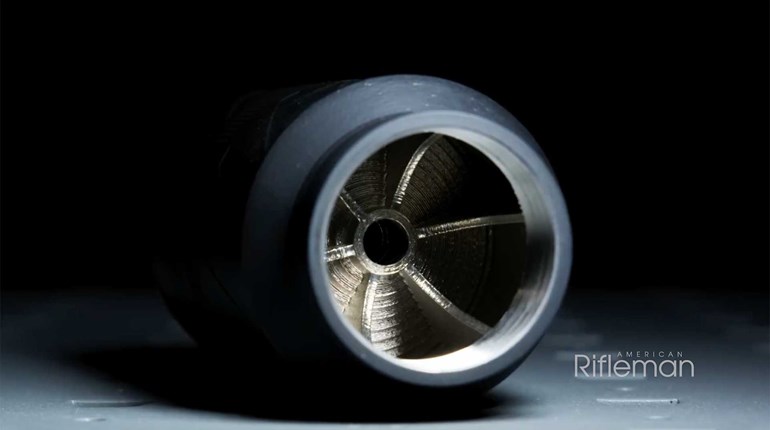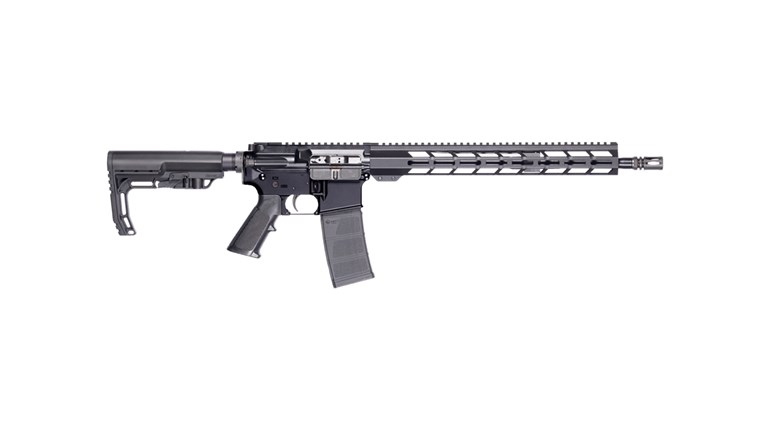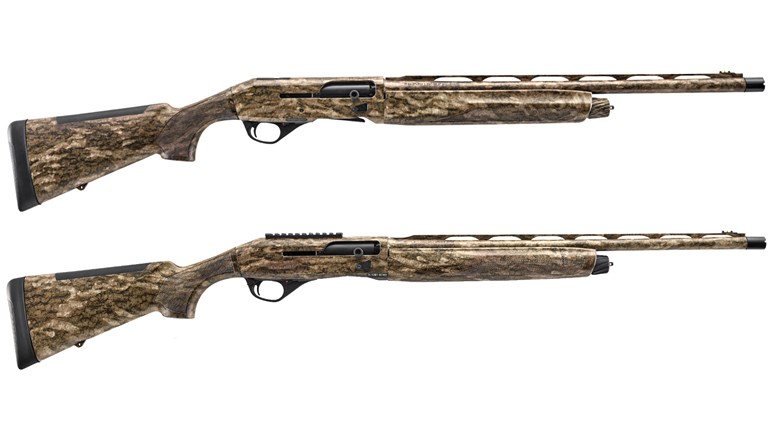
In an advertisement published in early 2018 Wilson Combat was touting that the company produces AR-pattern rifles in 17 different chamberings. You’re about to find out that its new ad is already outdated, and that we can up that ante to 18. Bill Wilson and his engineering staff are introducing the new Wilson Combat Tactical Hunter AR rifle chambered for an equally new cartridge, the .458 HAM’R.
Of course, as soon as we hear whispers of a new cartridge our first thoughts are: “What is it, and why do we need it?” At the same time, just mentioning .458 and AR in the same sentence will instantly evoke thoughts of the .458 SOCOM.
The Wilson Combat .458 HAM’R Cartridge
To compare the two cartridges is only natural, since at first look they appear to be the same round. The physical differences may seem minor—the shoulder of the .458 HAM’R has been moved forward by .04 inch and the primer has been changed from a large pistol primer to a small rifle primer—but the major difference is the HAM’R is designed to have a significantly higher maximum pressure rating, increasing to 46,000 psi from the 35,000 psi of the .458 SOCOM. The outcome of these changes is that the new .458 HAM’R cartridge will achieve velocities in excess of 200 fps faster than the .458 SOCOM while using the same bullet weights. And, of course, we know that when you increase velocity while maintaining the same mass, you increase energy as well.
In one move, Wilson Combat has unveiled both a new cartridge and rifle series, and both are sure to draw attention.
If this was a generation ago, the new name for the .458 HAM’R might have just been “.458 SOCOM Magnum,” and right about now some might be thinking that Wilson Combat is suggesting you can just increase the pressure rating of the .458 SOCOM. Don’t even think about it. The .458 SOCOM was designed for the AR-15 platform and the .458 HAM’R is designed for a new, hybrid Wilson Combat .458 HAM'R Tactical Hunter AR, developed to be better-suited for the increase in pressure. Now you understand the reasoning behind moving the shoulder forward by .04 inch. A .458 HAM’R round will not chamber in an AR-15 configured for .458 SOCOM. That said, a .458 SOCOM round may chamber in a rifle chambered for the .458 HAM’R, but there will be excessive headspace, and the round may or may not fire. Remember, there’s a good reason the .357 Mag. is longer than the .38 Spl. and the .44 Mag. is longer than the .44 Spl. While the less-powerful loads can be fired in the magnum handguns, you cannot shove a magnum load in a handgun not designed for the greater pressures developed by the magnum cartridges.
About the only reason I could imagine why someone would want to fire .458 SOCOM rounds in a .458 HAM’R would be the false belief that they could fire-form cases for the HAM’R. However, this would not incorporate the change in primer size. Understand that given nearly the same basic case dimensions, the velocity increase in the .458 HAM’R can be achieved by the use of powders and charge weights not suitable for the .458 SOCOM. This alone could account for the need to change primers. Besides, Starline Brass has worked with Wilson Combat throughout the development of this cartridge and is already gearing up to offer .458 HAM’R brass to reloaders. The .458 HAM’R will not be proprietary to Wilson Combat, and ammunition will be initially available from Wilson Combat and SBR Ammunition. This will also allow other companies to produce the .458 HAM’R, and I understand that another major manufacturer already has plans to bring out a rifle so chambered.
We have answered the “What is it?” part of the question, but let’s look at why we might need it. “Why?” was the simple question I asked Wilson, and he jokingly replied: “Because we can,” before explaining his goal for the .458 HAM’R. Wilson Combat wanted to produce the most-powerful and hardest-hitting cartridge possible that would fit in a medium-size AR. I think the company achieved that goal, since when you calculate the external ballistics of the .458 HAM’R, they exceed even the .450 Bushmaster, .458 SOCOM and the .50 Beowulf. Hunters will never face an animal in this hemisphere that cannot be taken with this cartridge, and in most tactical situations, no one could be better armed. With about 3,000 ft.-lbs. of energy created by the .458 HAM’R, this round can speak for itself. Yes, these numbers can be surpassed by the 7 mm Rem. Mag. and the .300 Win. Mag., but try fitting those into a rifle of sensible size for both the field and home defense.
Of course, there is a price to pay with any cartridge, and in the case of the .458 HAM’R it is range. This new round may have the edge on the .450 Bushmaster, .458 SOCOM and the .50 Beowulf, but all of them (including the .458 HAM’R) use bullets with a low ballistic coefficient (BC) and have to be considered short-range cartridges. However, out to 200 to 250 yards, even a grizzly has to offer respect.
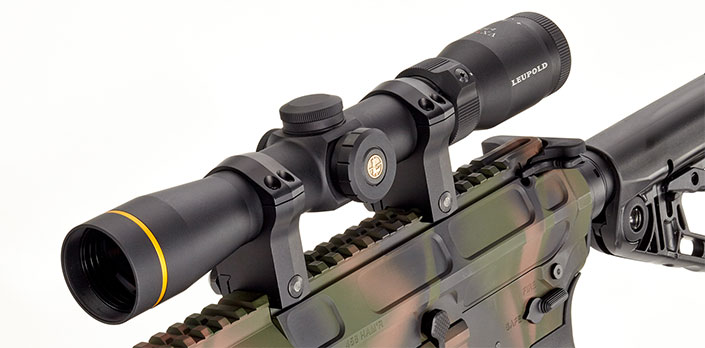
The Wilson Combat .458 HAM’R Tactical Hunter
As mentioned, the .458 SOCOM was designed around the AR-15 platform, and to change pressure ratings would require a change in rifle design. The Wilson Combat .458 HAM'R Tactical Hunter has been designed from the ground up for the new .458 HAM’R cartridge. The Tactical Hunter falls between the AR-15 and AR-10 platforms, with hybrid-length billet upper and lower receivers. The NP3-coated, bolt-carrier group is basically an AR-10 pattern shortened by .75 inch. Wilson Combat’s 18-inch, fluted barrel also features an AR-10-size barrel extension. These changes result in a rifle with the strength of an AR-10, but lighter and more compact.
The lower receiver is sized to accept a standard AR-15 magazine, and the 20-round Lancer magazine that came with the sample rifle held seven .458 HAM’R rounds. The mid-length gas system includes a SLR Rifleworks adjustable gas block, and the custom-length buffer and spring have been tuned for the new cartridge.
Features that may be considered as optional on some rifles are standard on the Tactical Hunter. Wilson Combat has the four points of contact between shooter and rifle covered with a Wilson Combat 14.6-inch M-Lok freefloat handguard with Falcon/Ergo rail covers, a Rogers/Wilson Super-Stoc and a Wilson Combat/BCM Starburst Gunfighter Grip. From my experience with the Wilson Combat TTU (Tactical Trigger Unit) on my personal rifles, I can attest that the Wilson trigger has a light and crisp pull second to none. The trigger in the Tactical Hunter is set right at 4 pounds from the factory and is quite consistent.
The Wilson Combat .458 HAM'R Tactical Hunter came in a new, subdued camo pattern of Wilson Combat’s Armor-Tuff finish applied over Mil-Spec anodizing—which I found rather appealing—and the rifle may be ordered in different colors and patterns. One aspect of this rifle that is somewhat hard to describe is the care taken in its hand-fitted assembly. Fit and finish were simply perfect.

At the Range with the Wilson Combat .458 HAM'R Tactical Hunter
There are pros and cons related to every trip to the range, and testing the .458 HAM’R proved to be no different. The pros were that even though this is a new round, Wilson Combat provided a good variety of ammunition. Of course, there’s a bit of excitement about testing any new rifle, especially one chambered in a new cartridge. The single con found in this range trip was the fact that we are talking about a round that is equal to a .45-70 Gov’t—even with a gas-operated rifle, felt-recoil was going to be noticeable.
Wilson Combat sent four different loads produced at its plant in Arkansas. There were two 300-grain loads, one with Barnes TTSX bullets and the other sporting the Nosler Ballistic Tip. The middleweight load was supplied with 325-grain Hornady FTX (FlexTip), and the heaviest sent was a 350-grain load with Hornady Interlock round-nose bullets.

The first load I tried was the 300-grain Nosler Ballistic Tip offering, and it instantly proved that Wilson Combat’s claim to a 200 fps boost over the .458 SOCOM was not an idle boast. Velocities averaged 2,066 fps, and this load gave me the best accuracy of the day. The Barnes 300-grain TTSX came next and upped the velocity to 2,132 fps. It shot groups only slightly larger than those of the Ballistic Tips. The loads using the 325-grain Hornady Flex Tips and the 350-grain Hornady Interlock bullets both resulted in expectedly lower velocities given their heavier weights.
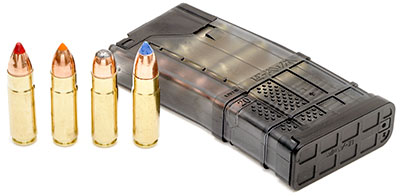
After firing for accuracy, I was able to take the remaining rounds and shoot from the bench. This is where the superior handling qualities of the Wilson Combat .458 HAM'R Tactical Hunter came into play. It is a well-balanced rifle, causing it to feel even lighter than its 7.75 pounds. Unfortunately, even though I have always thought I had decent form on the firing line, firing rapid shots with the new .458 HAM’R will take some practice. Regaining my sight picture wasn’t too slow, but it was far from being considered “rapid fire.”
You may have noticed that I did not mention any problems during my range sessions—there weren’t any. The rifle fed, fired and ejected without a single hiccup.
In one move, Wilson Combat has unveiled both a new cartridge and rifle series, and both are sure to draw attention. The .458 SOCOM has always been well-received, and there is no reason to suspect the .458 HAM’R will be any different. A large group of shooters have a distinct need for power in a handy, portable firearm, and the .458 HAM’R is bound to be at the top of the list of suitable cartridges. In a similar package to that of the .458 SOCOM, the .458 HAM’R offers greater velocity and greater energy. If you wonder how much impact the .458 HAM’R will make, just think back to the work of P.O. Ackley, who literally transformed dozens of cartridges—all with minor changes—and the results are considered improvements to the parent rounds.
To make the cartridge even more interesting, Wilson Combat has created a hybrid AR that falls between the AR-15 and the AR-10. The Wilson Combat .458 HAM'R Tactical Hunter is fine-tuned for smooth and trouble-free operation of the .458 HAM’R in a lightweight platform suitable for both tactical situations and hunting. Whether you’re facing a bruising razorback or a brutal felon, the HAM’R should stop them both cold.















